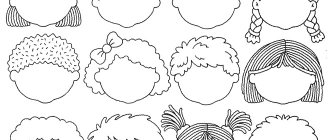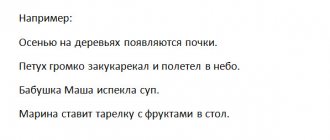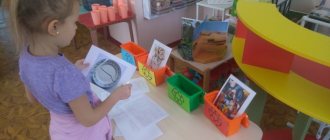What children need to know about emotions
By the senior preschool age, the child has already formed an idea of human emotions, which include:
- joy
- sadness
- fear
- anger
- resentment
- astonishment
Children define and name psychological states, briefly describe them, and give examples of everyday situations in which a person experiences them.
Pictures for children depicting emotions teach the child to reason, describe cause-and-effect relationships, and analyze his own life experience.
During speech therapy work, it is useful to offer preschool children topics related to people’s experiences to compose narrative stories. For example:
- Is it only humans who have feelings?
- What are positive and negative emotions?
- When am I happy and when am I sad?
Emotions can be divided into pairs with opposite meanings. For example: joy - sadness, disgust - admiration, boredom - interest, etc. Children should be able to recognize and name the feeling of the character in the picture, but also select antonyms for the definition. Exercises in this format allow you to more firmly consolidate the characteristics of emotions.
Children should know that we can learn about a person’s psychological state both from words and by observing actions and behavior. Each emotion has a corresponding dictionary and a set:
- gestures
- facial expressions,
- actions
It is useful to have conversations with older preschoolers about how their emotional state needs to be managed, especially when it comes to negative feelings. You cannot give free rein to anger, irritation, or sadness. Express feelings only in socially acceptable ways. Children will be interested to know that in countries around the world people express feelings in different ways.
Passport. Didactic game "Emotions"
municipal budgetary preschool educational institution
"Kindergarten No. 42"
Department of Education of the Administration of the Sovetsky District of Krasnoyarsk
st. Yastynskaya, 11a, Krasnoyarsk, 660131, tel. (8-391) 2239-192 E-mail: [email protected]
Didactic game "Emotions"
Preparatory school group No. 6 “Sun”
Teacher of the first qualification category
Popova Daria Gennadievna
Relevance.
Preschool age is a favorable period for organizing work on the emotional development of children. He clearly shows the inseparability of emotions from the processes of perception, thinking, and imagination.
In recent years, the number of children with disorders of psycho-emotional development has been increasing. Typical symptoms of these disorders in preschoolers include emotional instability, hostility, aggressiveness, anxiety, etc., which seriously complicates the child’s relationship with the outside world. In addition, against the background of such violations, secondary personality deviations easily arise, causing negative behavior and communication patterns, and deformation of the personal growth of children in general. Accordingly, organized psychological and pedagogical work in this direction can not only enrich the emotional experience of a preschooler, but also significantly mitigate or even completely eliminate shortcomings in personal development.
Emotions play an important role in children’s lives; they help them perceive reality and respond correctly to it. Feelings dominate all aspects of a preschooler’s life, giving them a special coloring and expressiveness, so the emotions that he experiences are easily read on his face, in posture, gestures, and in all behavior.
Target
: teach children to identify and name a person’s psycho-emotional state.
Tasks:
- Teach children to understand their own conditions and those of those around them.
- Give an idea of ways to express your own emotions (facial expressions, gestures, posture, words).
- Improve your ability to manage your feelings and emotions.
Age:
5-7 years
Game making material:
laminated paper, Velcro, panel carpet.
Equipment:
— Playing field (screen-pano)
- container
Option 1a. "Collect and name"
Purpose of the game:
learn to name a person’s psycho-emotional state.
Progress of the game:
The child posts a cut-out picture and names the person’s psycho-emotional state.
Option 1b. "Tell me about the situation"
Target:
developing the ability to understand the situation and select the appropriate emotion for the character.
Progress of the game:
the child posts a cut-out picture and describes the situation, naming the person’s psycho-emotional state.
Option 2. “Emotions are lost.”
Target:
form the emotional vocabulary of preschoolers
Progress of the game:
The teacher offers to choose the same emotion for a boy or girl.
Option 3. “Gather the emotion”
Target:
develop the child’s emotional sphere, the ability to correlate the expression of the eyes with the expression of the mouth.
Progress of the game:
the child assembles the portrait correctly, choosing the expression of the eyes and mouth.
Defining emotions for children
For speech therapy work with students in the senior and preparatory groups of kindergarten, use the following list of emotional states:
Joy is a positive emotion familiar to everyone. We feel joy when something good happens. A person can express this feeling through words and actions. Signs of a joyful state are laughter and smiling. Experiencing joy feels good, as does bringing it to others.
Sadness is a feeling that appears when we learn or think about something sad. Sadness cannot be called a strong emotion; it passes quickly. This does not mean that you should not allow yourself to be sad; sometimes every person needs it. But you shouldn’t indulge too much in a sad mood; it’s more useful to try to quickly get rid of it by doing something pleasant or useful.
Anger is anger, strong irritation towards someone or something. Feeling angry is not pleasant, but sometimes it happens to everyone. It is a strong emotion that can cause trouble for us and others. It is important to explain to children how to manage anger and be able to express it correctly. If a person is often angry, then it is difficult for him to find friends, he is often lonely.
Fear is a strong negative emotion that people experience if they are threatened by something. The danger can be real or expected or imaginary. Every child has repeatedly felt fear, so he can easily recognize its image in illustrations or photographs, and also give examples of events, objects and phenomena that cause this feeling in them. Children should know that fear varies in intensity, from fear to horror. It is important to explain to children that this emotion is necessary for a person, as it warns of danger. It can be added that the color black is often used to illustrate fear in pictures.
Admiration is a pleasant emotion that arises when encountering something very beautiful or unusual. Admiration can be caused by: an unusual toy, a garden in bloom, an elegant girl. People, expressing admiration, use special exclamations: (oh, ah, wow, wow) and words (really, amazing, wonderful, wonderful, extraordinary). Admiration can be so strong that it is very difficult to express your feeling in words. From a photograph or drawing, preschool children can easily recognize a person who admires something, although it is difficult for them to describe his feelings; this requires special speech therapy training.
Shame is an unpleasant feeling that occurs when we have done something bad and regret it. The older the children, the easier it is to explain to them the essence and meaning of this emotional state. Signs of shame are not only certain facial expressions, but also redness of certain parts of the face (cheeks, ears, neck). Knowing this feature will help preschoolers quickly and easily recognize shame in drawings (by the way, this sign can often be seen in story pictures for children and even in selfies) and in the behavior of people around them. You can have a conversation with children 6-7 years old about the difference between shame and shyness; these states are easy to confuse.
Resentment - a person feels resentment when someone’s action seems unfair to him. Some people are touchy, others rarely experience this emotion. It is difficult to describe the state of resentment; preschool children should be able to recognize its image. To do this, you can use both schematic images (for example, emoticons - simple pictures of emotions for children), and realistic drawings, color or black and white photographs. By the way, it is convenient to print such visual material from collections and presentations on specialized speech therapy websites.
Drawn pictures
Emotions in pictures for children, used for classes on speech development, are presented in several versions: images of adults and children, people or fairy-tale characters. Printed pictures and drawings created by children are suitable for the development of speech in preschoolers.
Invite the children to draw themselves or another person experiencing a certain feeling. Drawing up a verbal explanation for such a picture is a speech therapy exercise that the children do willingly.
If children are not yet able to cope with independent depictions of emotional states, it is worth inviting them to create a collage from pre-prepared and printed facial details. Preschoolers aged 6-7 years are able to recreate emotions on paper on their own, but for younger children it is worth using ready-made templates and samples.
In speech therapy work, you can use not only drawing, but also coloring. Thematic coloring books are a useful and exciting material that is indispensable for girls and boys in kindergarten and at home.
It is important to first thoroughly study with children not only the names of different emotions, but also those artistic techniques that allow you to accurately convey one or another psychological state of a person. The use of pictograms can be very helpful in this regard.
What do different emotions look like?
Anger - the eyebrows are lowered to the inner corners of the eyes, the eyes are narrowed, the mouth is tightly compressed or slightly open, teeth are visible.
Fear - eyebrows raised, eyes widened, mouth open
Sadness - the outer tips of the eyebrows are lowered, the eyelids and corners of the lips are half-lowered.
Surprise - eyebrows raised, eyes rounded, mouth slightly open.
Joy - eyebrows are slightly raised, eyes are narrowed, the corners of the lips are raised.
Calm - eyebrows, eyes and mouth are in a calm state.
Rules of the game “JOURNEY TO THE WORLD OF EMOTIONS”
Children from 5 years old
Number of players: 1-18
Dear parents and teachers!
Here is an interesting and educational game that is aimed at developing the emotional world of children and the ability to feel the emotional state of the game’s characters.
Preparing for the game
Carefully cut the cards along the dotted lines. You will get 18 cards with images of fairy tale characters, 12 cards with images of parts of faces. Cut and glue the paper cube.
Option 1
To play, you will need a cube with emotion patterns on its faces, and 18 cards with fairy tale characters. The presenter places the cards face up on the table.
The order of moves is determined.
The first player rolls the dice, looks at the dropped emotion diagram, names it (for example, sadness) and finds a card of a fairy-tale hero with the same emotional state (Pierrot). If the player completed the task, he keeps the card; if not, he puts it back.
The winner is the one who collects the most cards with fairy tale characters.
The presenter gives the players cards with characters from one fairy tale and gives the task: arrange the cards in order so that at the beginning there is a card with the most pleasant, positive emotion for the player, and at the end - with the most unpleasant, negative one.
Players explain their choice. The most accurate and original answers are marked by the presenter.
Option 4
Number of players 1-18.
To play you need cards with images of fairy-tale characters.
The cards are shuffled and placed face down on the table. Players take turns taking cards and looking at the drawing, and then depict the emotion of the fairy-tale hero with facial expressions.
A LITTLE ABOUT EMOTIONS FOR ADULTS
All emotions are expressed on a person’s face through facial expressions - movements of the eyebrows, mouth and eye expression. Because of this, appearance, depending on the emotional state, changes.
Option 2
Number of players: 1-6.
To play you will need 12 cards with images of parts of faces and 6 cards with fairy tale characters in various emotional states: joy, anger, fear, surprise, calm, sadness.
The presenter gives the players cards with images of fairy-tale characters, clarifies their emotional state and offers to draw up a “portrait” of the fairy-tale hero, describe him using cards with images of parts of faces.
The winner is the one who compiled the best “portrait” of the fairy-tale hero.
Option 3
Number of players: 1 - 3.
Pictograms
Schematic representations of various emotions greatly help children in learning, remembering and recognizing human emotional states. Especially in the early stages of getting to know this topic. Various sets of “Emotions emoticons pictures for children” contain cards with a conventional image of anger, joy and other feelings.
Games with pictograms
Games with pictograms are a whole area in the work of speech therapists and psychologists. Schematic images of emotions (faces) are excellent material for stimulating a child’s speech activity. Here are some examples of using such images:
Pick and name
Prepare pictures of pictograms with different emotions and feelings for children. The task is to find out this or that state, give it a name, and then come up with a situation in which it would be appropriate. Children can use both their personal experience and remember the heroes of famous fairy tales and cartoons. It’s okay if at first the descriptions of emotions sound childish, gradually regular speech training will help these stories become more perfect.
Find a match
If you take a cut set of emoticon pictures and mix them up, you will get an exciting game for a team of preschoolers, which can also be used in speech development classes. The task is to collect all the images. It is important that each emoticon accurately expresses a particular feeling, then the emotion will be easier to recognize and describe.
Transformations of moods
For this game you need to select the following emoticons, pictures of emotions for children, which can be sorted into opposite pairs. For example, sadness-joy, admiration-disgust, etc. Ask the children to take one card or a round smiley face, and then match the selected picture with a pair. After this, you can invite the children to come up with a story about what could turn one emotion into another.
Koloboks
The image of a kolobok is similar to a smiley face, so also use pictures with this character as pictograms illustrating emotions.
Use Kolobok’s drawings on a transparent background, so it’s easier for children to analyze the psychological state of the hero, and not the plot twists that happen to him.
There are many options for games with this fairy-tale character. For example, tell a Russian fairy tale, describing the emotions of Kolobok and other characters. The use of puppet theater or masks will help make this activity productive.
Emotions in the country of Smeshariya
Toys from the cartoon Smeshariki - material for classes on speech development in preschool educational institutions and at home. Images of funny round characters can be used to illustrate emotional states. Buy a ready-made manual or make it yourself, cutting out and signing characters from a magazine or book.
Offer the children pictures of Smeshariki and ask them to name the feeling that Nyusha, Kar-Karych, Krosh and other characters experience.
Card index of games for the development of the emotional-volitional sphere of children 3-4 years old.
SP DS "Solnyshko" GBOU secondary school s. Malaya Malyshevka
Municipal district Kinelsky, Samara region
Card index of games for the development of the emotional-volitional sphere of children 3-4 years old.
Educator
1 qualification category
Bikmurzina O.V.
Emotions and will are very important in the life of every person, starting from childhood - they control the perception of the surrounding world and influence the cognitive processes of the individual. This area develops throughout life, with preschool age considered the most important period for this development. It is necessary to carry out work on the development of the sphere of emotions in the preschool period, since it is now that its main aspects are being formed and consolidated. Positive emotions and willpower will be useful to the child in the learning process, and will also help him achieve success in extracurricular activities.
A card index of games for the development of the emotional-volitional sphere helps me carry out this work.
No. 1 "My name"
Goal: helps create a comfortable environment for everyone
participant.
Each participant speaks in a circle about which sound of his name he likes best (Lena, Lenochka, Alena, Elena., and what he doesn’t like. What he wants to be called in the group. After this exercise, you can repeat again, who will be what now call in the group (Lena or Lenochka, etc.)
No. 2 “Find out who called you”
Goal: development of children’s feeling for each other, differentiation of auditory perception, correlation of a person and his sound image, development of empathy .
Children, each in turn, stand at the end of the room and close their eyes - they lead. Two people from the group take turns calling the driver by name. The driver’s task is to guess, guess who called him. If the children know each other well, then you can complicate the task by asking the children to change their voice.
No. 3 “Polite words”
Goal: development of respect in communication , habits of using polite
words.
The game is played with a ball in a circle. Children throw a ball to each other, saying polite words. Then the exercise becomes more complicated: you only need to say greeting words (hello, good afternoon, hello, thanks (thank you, thank you, please, apologies).
No. 4 “Glue rain”
Goal: developing a sense of team , relieving emotional and physical stress, learning to coordinate your movements with others.
Children stand in one line, put their hands on each other’s belts, and like this “train” (glued raindrops) begin to move. On the way they encounter various obstacles: they need to step over boxes, walk along an improvised bridge, go around large boulders, crawl under chair, etc.
No. 5 “Glomerulus”
Goal: establishing contact, friendly relationships.
Children sit in a circle, the leader, holding a ball in his hands, wraps a thread around his finger, asks any question he is interested in to the participant in the game.
For example: “What is your name, do you want to be friends with me, what do you love, what are you afraid of,” etc., he catches the ball, wraps the thread around his finger, answers the question, and then asks his to the next player. Thus, at the end the ball is returned to the leader. Everyone sees the threads that connect the participants in the game into one whole, determines what the figure looks like, learns a lot about each other, and unites.
NOTE: If the leader is forced to help a child who is having difficulty, then he takes the ball back, prompts it and throws it to the child again. As a result, you can see children who have difficulty communicating - the leader will have double or triple connections with them.
No. 6 “Friendship begins with a smile”
Those sitting in a circle hold hands, look their neighbor in the eyes and silently give him the kindest smile they can, one by one.
No. 7 “Good animal”
Participants stand in a circle and join hands. The leader says in a quiet voice: “We are one big, kind animal. Let's listen to how it breathes! Everyone listens to their breathing and the breathing of their neighbors. “Now let’s breathe together!” Inhale - everyone takes a step forward. Exhale - everyone takes a step back. Inhale - everyone takes 2 steps forward, exhale - everyone takes 2 steps back. Inhale - 2 steps forward, exhale - 2 steps back. “This is how the animal not only breathes, its big, kind heart beats just as clearly and evenly. A knock is a step forward, a knock is a step back, etc. We all take the breath and heartbeat of this animal for ourselves.”
No. 8 “Polyagushechki”
Children gather around the teacher, squat down and close their eyes.
The teacher says: “So we woke up and stretched sweetly.” Children open their eyes, slowly stand up, stretch their arms forward, then raise them up, take them behind their heads and rise on their tiptoes.
The teacher says: “We reached out sweetly, smiled at each other.” Children stand on their feet and let their hands down. The exercise is repeated several times.
No. 9 “I can”
Children sit in a circle. The teacher asks everyone to close their eyes and remember how much they can already do on their own. This can be any skill, not just the most important and useful. Then the teacher asks you to open your eyes and start the game.
In a circle, each child names and, if desired, shows his skill. For example: “I can run fast (hammer nails, water flowers, jump, etc.).” Children must listen to each other because each skill can only be mentioned once.
No. 10 “Shouters, whisperers and silencers”
The teacher says: “Guys, pay close attention to the squares that I will show. If you see a red square, you can jump, run, scream. If it’s yellow, you can only whisper, but if it’s blue, you need to freeze in place and be silent.”







